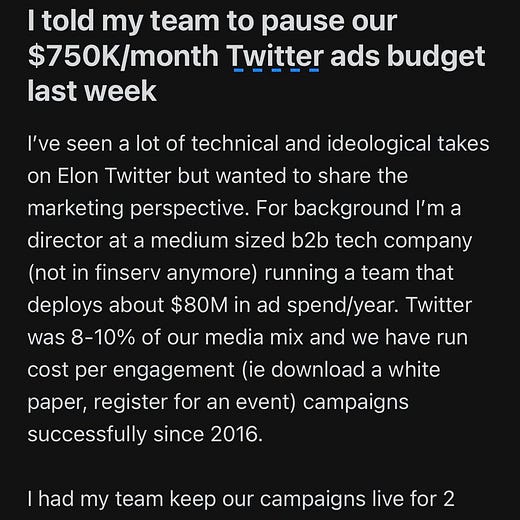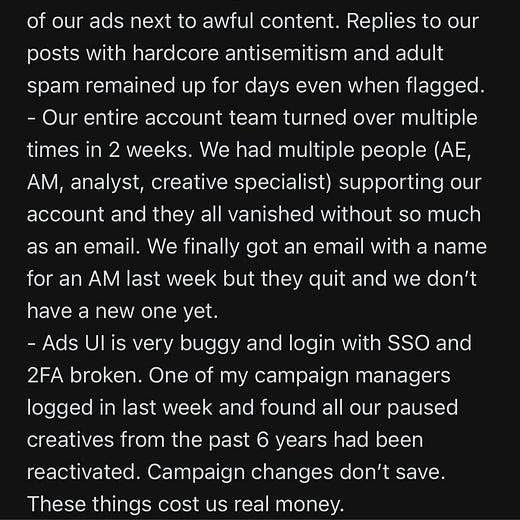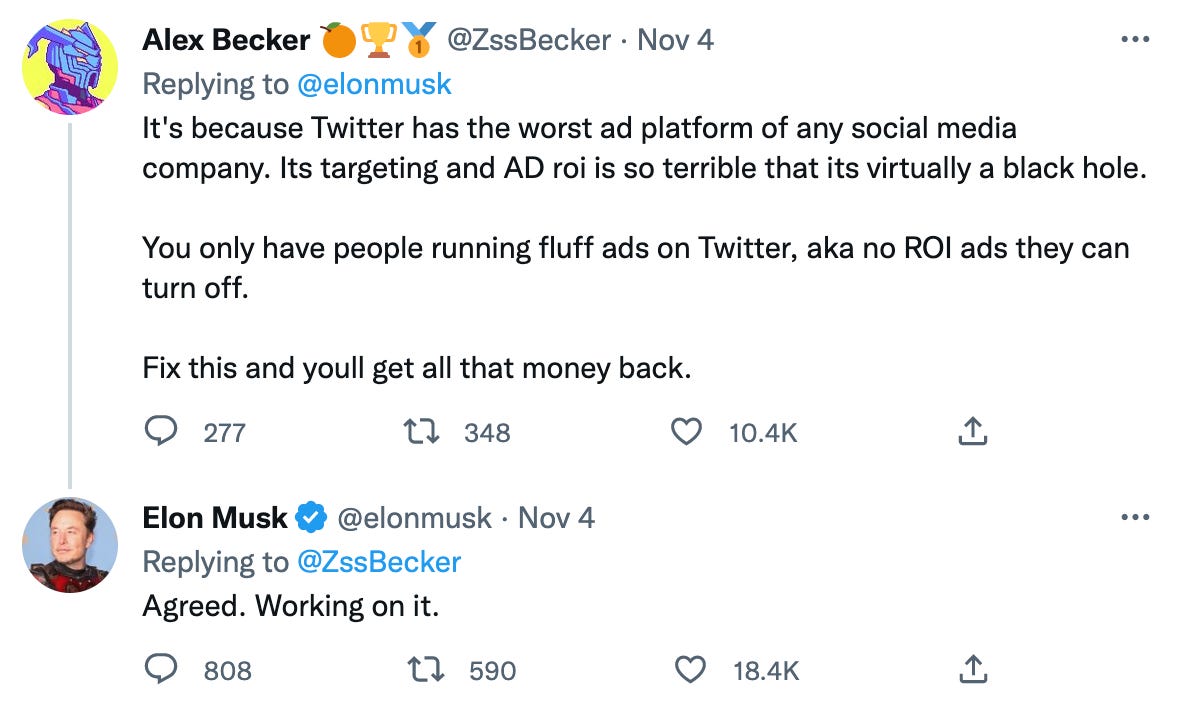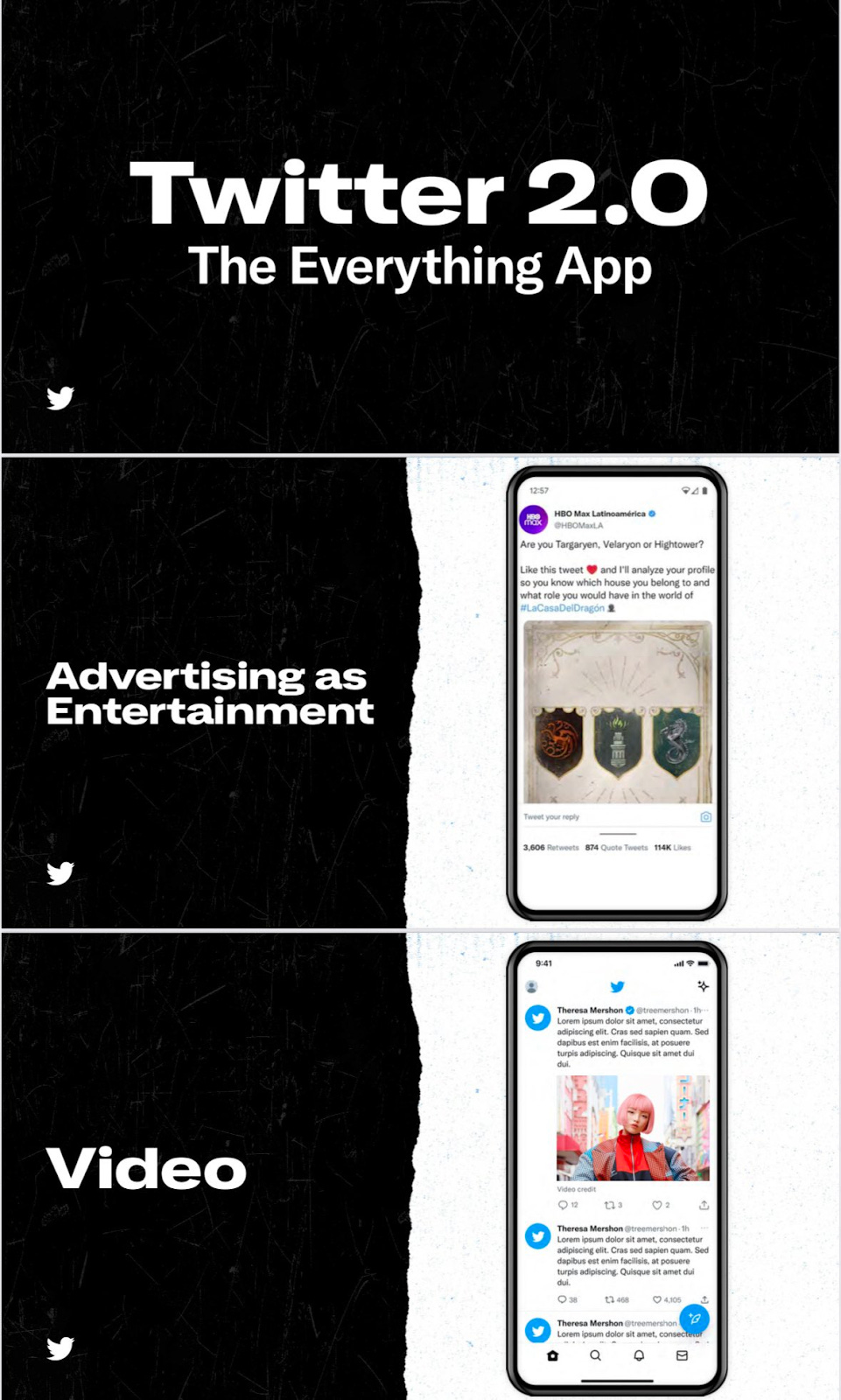Twitter 2.0, Final Part: Ads and User Acquisition
Twitter 2.0, Final Part: Advertising and User Acquisition
In social media networks like Twitter, you have three tasks:
User Acquisition: Get new users.
Retention: Keep these new users coming back to the site.
Monetization: Make money out of their time on the site.
In Part 1 of this series, we focused on retention. Part 2 was about monetization via subscriptions. Today, we have the 3rd and final part. We cover the other half of monetization—ads—and user acquisition, which is under a paywall. I decided to not write an article about Elon Musk’s management of Twitter. If you want to read that, let me know and I might write it.
Twitter 2.0: Advertising Strategy
The Virtue-Signaling Advertisers Sideshow
Apparently, brands stopped advertising on Twitter when Musk took over.
I think this is mostly a sideshow.
It’s true they don’t like advertising alongside racist tweets and want to avoid a backlash from activists.
But it’s one of many many issues.
What companies want is results. If Twitter advertising brings results, they will spend their time and money on Twitter. Anything else is performative activism.
Twitter has instead a problem of Return on Investment (ROI) of their ads.
Why Do Ads Have Lower ROI on Twitter?
Advertisers on Twitter pay mostly for what’s called “brand advertising”, which basically means “pay to show your ad, because odds are people won’t click on it.” This is as opposed to “performance advertising”, where you don’t pay for somebody seeing your ad, but rather for people to make a specific action. You can see that Twitter’s ads are about 55% less valuable than Facebook’s1.
So Facebook’s audience is 4x as big as Twitter’s, and each one of their ads is 130% more valuable than Twitter’s. No wonder Facebook is so much more valuable than Twitter.
Why are their ads less valuable?
This can’t be an obvious thing to solve. Twitter probably had hundreds of people working on this problem for years. But we can gather some hints.
For starters, what type of ad do you get on Twitter? Promoted Tweets.
What about Facebook and Instagram? You can get full-screen video ads, for example, which are so much better to catch the user’s attention. How much has Twitter played with new formats?
Another glaring shortcoming of Twitter is targeting. Apparently, the problem is that you put much more personal information on Facebook than on Twitter.
This doesn’t make that much sense to me. Facebook knows a lot about you, but not just by what you tell the company. They know by what you do on the platform. Similarly, Tiktok has shot up to the top of the social media companies in the world without people creating detailed profiles. They only pay attention to customers’ actions.
Twitter could do the same. We’ve seen last week how it’s pretty dumb on content personalization. If they don’t know what to recommend to you, that’s because they don’t know you—so they can’t sell that information to customers. But content personalization is doable. Just do what Tiktok does.
If you’re a power user of Twitter, you’ll also notice that the format of Twitter ads is easy to recognize, so it’s very easy to avoid them. This, to me, is the most fundamental opportunity for Twitter Ads.
Advertisers = Creators
From last week’s article:
Twitter is a 3-sided marketplace. It has viewers, creators, and advertisers. Their relationship is a bit messy, but it can be simplified by breaking it down into two pieces:
1.The Content Marketplace, between viewers and creators.
2.The Advertising Marketplace, between viewers and advertisers.
Last week, I started with the marketplace between viewers and creators. Today, we’ve been talking about the marketplace between viewers and advertisers. This is very much how Twitter treats them internally: separately.
The big orange block in the middle is the Timeline Mixer (which will be replaced in the future by the pink one, the Home Mixer). Its responsibility is to mix the different types of tweets in one place. I circled the green ones on the right: These are the core of the experience, scoring tweets and ranking them so you can see them in your timeline. Then, in blue above is the Ad Mixer, which decides which ads you will see, interspersed in your timeline2.
Compare these two ads:
One is a crappy ad you can immediately identify and avoid. The other one is an obvious viral winner3. They represent the two marketplaces competing for attention.
But what if this didn’t need to be this way? What if these marketplaces could be the same? What if advertisers could be considered creators?
Creators try to get impressions through quality content, but that’s hard.
Advertisers get impressions by spending money, but that’s expensive, and results in shitty content.
What if you could combine both?
What if brands tried really hard to create good content, and were rewarded for it?
What if creators, when they finally hit a viral tweet, could boost their performance?
Tweets today are either viral or paid. If you make a viral tweet, you have no incentive to pay, because you would need to spend a huge amount of money to get a fraction of the impressions you get for free. So you only have an incentive to pay if your tweet is bad!
If instead you had an incentive to promote successful tweets, then brands would make a much bigger effort creating good content in order to promote it, and viewers would benefit from ads that are of good quality.
For Twitter to enable this, it would need to allow promoting tweets, but not the way it does today (paying for clicks or impressions), but rather as a viral boost.
If your tweet is getting a million impressions, many people are enjoying it. Creators and companies would be eager to spend a fair amount of money to get it to two million impressions, because that way they would get quality content in front of people and gather new followers in the process. Meanwhile, the people viewing the content would enjoy it too, since it’s good content. Twitter could target these people as lookalikes: People similar to those who enjoyed the tweet in the first place.
If the cost of a CPM is about $10 on Twitter, a million impressions would cost $10k. This is prohibitive for any creator. If instead you paid for a viral boost—say, 10% increase in virality of your tweet—it could be more affordable for creators. How much would the creator of the tweet with one million impressions pay to increase their reach to 2 million? Maybe $100?
This is 100 times less per impression than the CPM that brands pay. But it also improves the experience rather than making it worse! Twitter could have substantially more promoted tweets—today, they limit the number of promoted tweets you see because either brands don’t want to advertise, or viewers don’t tolerate many ads because they’re bad.
This would allow Twitter to extract some value from the people who benefit the most from Twitter today—those with a huge audience—but who aren’t paying for the privilege. Why get $8 per month from them when you could get hundreds of dollars?
Interestingly, Twitter is going in the other direction right now, suggesting that they will give companies a badge with a different color than the blue one they have currently. How is it a good idea to make it easier for viewers to notice when a brand is writing to them? A different color for companies won’t work. It will make it twice as obvious when it’s an ad.
But it looks like they might have noticed this idea of linking creators with advertisers.
Based on the example they share, though, they might be embarking on a much harder path.

Delivering on this is out of reach for 99.99% of companies in the world. Better to simply let them advertise their successful tweets.
Stop Penalizing Outlinks
Creators believe that Twitter penalizes the reach of your tweets if they have a link that sends viewers outside of Twitter. This is a problem. If it’s false, Twitter should clearly state it. If it’s true, they should stop4.
I get why they’d do it
Takeaways
To increase its advertising revenue, Twitter should:
Play with new formats, including more immersive video, especially on mobile web and app.
Allow targeting based on understanding user profiles, which they can extract from intelligently analyzing their behavior on the platform.
Allow promotion of viral tweets by adding a viral boost, rather than paying on a CPM basis. Make it affordable for any creator to be able to pay.
Rethink—or at least test very thoroughly—giving a different color badge to companies. Their ad performance could go down.
Stop penalizing outlinks
Now let’s talk about what Twitter could do about user acquisition.










